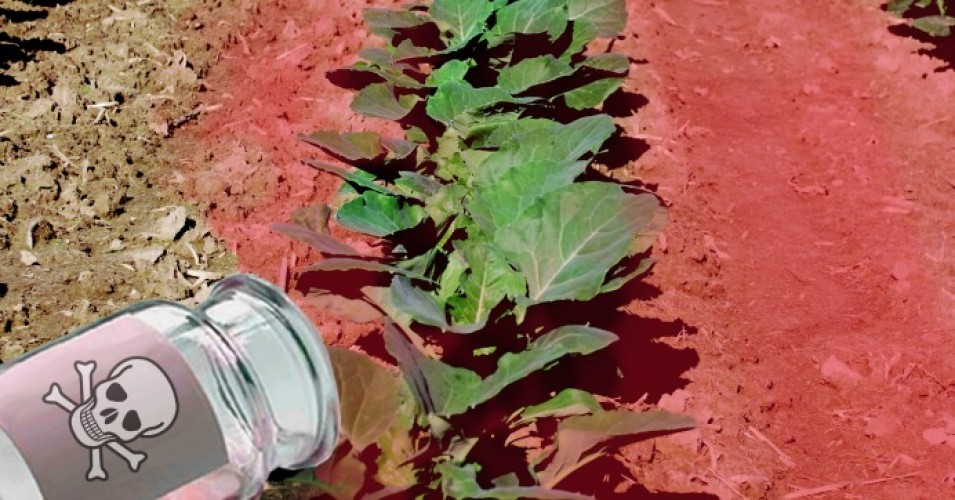From 2017-2018, the agency approved 69 new pesticide products containing an ingredient the EPA recognizes as a “known” or “likely” carcinogen.
By Andrea Germanos, staff writer for Common Dreams. Published 1-10-2020

A detail of the cover image for Toxic Hangover, a new report by Center for Biological Diversity. (Image: Center for Biologicial Diversity)
A new review into the pesticide products the U.S. approved in 2017 and 2018 reveals the Environmental Protection Agency is carrying out an industry-friendly, “broken” regulatory process that included green-lighting over 100 products with ingredients widely deemed extremely dangerous.
Entitled Toxic Hangover: How the EPA Is Approving New Products With Dangerous Pesticides It Committed to Phasing Out, the 11-page analysis was released Tuesday by the Center for Biological Diversity.
Nathan Donley, senior scientist at the Center, authored the study. He said the agency was acting “recklessly.”
“It’s disgusting that rather than do the right thing and phase out the worst of the worst pesticides, the EPA is quietly encouraging their ongoing use,” Donley said in a statement.
Among the findings is that the EPA appears all-too willing to give its stamp of approval to pesticides, the study found. To wit: the agency authorized 1,190 end-use pesticide products, which includes herbicides and fungicides. Just 71 such products were not approved in that time frame, meaning about 94 percent were. Where records were available regarding the lack of approval, the reasons were due to deficiencies with the minimum study required or packaging requirements—in other words, the rejections were not based on a product’s toxic threat.
“When the EPA is approving 94% of applications that come across its desk, including for some of the planet’s most dangerous pesticides,” said Donley, “it’s obvious the safety review process is completely broken.”
The products that were approved give cause for concern.
The bottom line, said the analysis, “the agency is actively working against its own efforts to incentivize the replacement of older, more dangerous pesticides by approving new pesticide products that contain these same dangerous ingredients.” As the Center outlined, the EPA approved
- 15 new products containing neurotoxic carbamates or organophosphates (OPs), including chlorpyrifos.
- 17 new products containing the endocrine disruptor atrazine.
- Six new products containing paraquat, which is so lethal that one spoonful can kill a full-grown adult.
- Four new products containing the extremely dangerous airborne fumigants methyl bromide or chloropicrin.
- 91 new restricted-use pesticides, so dangerous they can only be applied by a professional.
- 69 new products containing an ingredient the EPA recognizes as a “known” or “likely” carcinogen.
Roughly a third of the products approved over the two-year period have more than one active ingredient, with some containing as many as six. That’s cause for concern. From the report:
When the EPA analyzes the harms associated with pesticides, it only takes into account exposure to a single active ingredient at a time. This practice fails to fully capture the risk and potential harms that can be caused by 1 out of every 3 products it’s approving. This is in addition to the EPA’s refusal to consider the impacts of interactions between active ingredients and other ingredients in formulated products that can result in increased toxicity. This refusal to analyze harm from ingredient mixtures, the same mixtures that are sold on store shelves, calls into question the effectiveness of a risk-assessment process that ignores these highly relevant exposures.
The EPA’s approach of weening out dangerous products by waiting on companies to voluntarily cancel them just doesn’t cut it in terms of protecting human health and the environment, the study says. Evidence for that is seen, for example, in fact that the use of some “Restricted Use Pesticides”(RUPs)—a classification which includes like atrazine—has either remained constant or gone up.
“Approving new pesticides alone is manifestly not an effective way of replacing older pesticides,” the anaysis said.
The bottom line, according to the report, is that the EPA “is actively promoting the use of the worst pesticides and ultimately impeding the transition to safer and more sustainable agriculture in the United States.”
The report calls for the EPA to instead stop green-lighting products with the most dangerous ingredients and work decisively to truly phase-out the most dangerous products.

